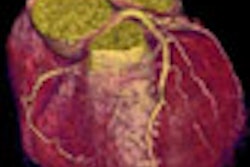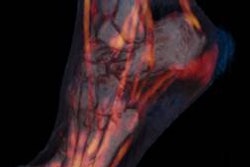Researchers have long sought early prognostic clues for lung cancer patients -- ideally signs that are early enough and robust enough to alter patient management. On both counts it appears that researchers from the Netherlands may be on to something.
In the latest of two recent studies, which included a Belgian center, the group performed serial PET/CT scans in patients with non-small cell lung cancer (NSCLC). They found that the maximum uptake of FDG correlated not only with increased survival, but with two plasma biomarkers. The study supports preclinical data suggesting that hypoxia is associated with higher FDG uptake (Radiotherapy and Oncology, May/June 2007, Vol. 82, pp. 145-152).
Earlier this year, several in the group published another study of FDG uptake in lung cancer patients. The results showed marked differences between patients who would eventually respond to radiotherapy treatment and those who did not, leading to the search for broader correlation with plasma markers.
The results are intriguing because they could potentially be used to improve prognosis and patient management decisions regarding the efficacy of various treatment options, explained the authors from University Hospital Maastricht in the Netherlands and University Hospital Leuven in Belgium.
Radiotherapy, despite its usefulness in the management of advanced NSCLC patients, still fails to control tumors in most patients, wrote Dr. Angela van Baardwijk, Dr. Geert Bosmans, Dr. André Dekker, and their colleagues in Maastricht.
"Local tumor control can be improved by increasing the total radiation dose and the addition of chemotherapy to radiotherapy, but normal tissue toxicity, like esophagitis and radiation pneumonitis, is dose-limiting," they noted (Radiotherapy and Oncology, February 2007, Vol. 82, pp. 145-152).
Early FDG uptake predicts lung cancer radiotherapy response
The February study led by van Baardwijk noted previous correlations between standardized uptake values (SUV) in PET and cancer outcomes. But the group was looking for ways to use the information earlier -- for treatment planning rather than simply staging and assessing treatment response.
"The maximal uptake of (18-FDG) in the primary lung tumor as measured on a PET scan before treatment was consistently shown to be a significant, independent, prognostic factors for survival in NSCLC, both in case of surgical resection and radical radiotherapy," they wrote. "On the other hand, a post-treatment PET scan can predict residual disease and hence outcome. We hypothesized that changes in uptake might reflect early tumor response during radiotherapy, which might finally allow further individualization and adaptation of treatment before therapy is completed."
Over two years the Maastricht team performed a series of four PET/CT scans on 23 NSCLC patients, recording changes in maximal uptake values SUVmax over the course of the scans.
Repeat PET/CT scans were acquired on a Somatom Sensation 16 with ECAT Accel PET scanner (Siemens Medical Solutions, Erlangen, Germany) a median of nine days before the start of radiotherapy, at days seven and 14 during treatment, and 70 days after completion of radiotherapy. CT was used to scan the entire thorax; FDG was injected in varying amounts based on patient weight, and PET scans were acquired after a 45-minute delay.
Among the 23 patients, 20 received platinum-based chemotherapy, while three did not. In the chemotherapy group, 15 patients had partial remission and five showed stable disease.
Among nonresponders, FDG uptake rose sharply during the first week of treatment, then rose moderately during the second week. In contrast, the eventual responders had stable or declining uptake rates at the beginning of treatment.
The most striking result was the large heterogeneity in the evolution of SUVmax values, the authors wrote.
Among responders there was no change in SUVmax during the course of radiotherapy. "Only after radiotherapy, a mean decrease of 46% of the SUVmax was observed from 5.0 ± 0.8 on day 14 during radiotherapy to 2.7 ± 0.4 70 days after radiotherapy (p = 0.02)," they wrote.
In contrast, nonresponders had a significant increase of SUV in the first week of radiotherapy, with an average SUVmax before treatment of 8.9 ± 1.1, which increased to 13.2 ± 1.7 during the first week of treatment (p = 0.22). At week two, SUVmax decreased to an average of 11.5 ± 1.3 (p = 0.04), decreasing further after therapy to a mean of 6.9 ± 1.2 (p = 0.02).
Nonresponders showed significantly higher SUVmax values at all time points in the study, and showed a significant increase during the first week of treatment, the authors added. For all patients there was a nonsignificant increase in SUVmax during the first week (p = 0.05), and a decrease in the second week (p = 0.02) and after radiotherapy (p < 0.01).
Clinically, patients with a metabolic response 70 days after radiotherapy had significantly longer survival (estimated 100% after nine months) compared to those with stable or progressive disease (estimated 63% survival at nine months), and no difference was found between responders and nonresponders in total prescribed radiation dose or overall treatment time.
"Until now the PET scan is mainly used before start of radiotherapy for staging purposes, to delineate the primary tumor and/or mediastinal lymph nodes, and after therapy to assess the remission status," the authors wrote.
Further study is needed to assess the significance of these results, but the differences between responders and nonresponders may reflect tumor characteristics and "might finally be useful to adapt treatment," they wrote. "The final goal being prediction of response early during the course of radiotherapy to enable early adjustments, like prescribing a higher total dose, adjusting the fractionation scheme, or adding another form of treatment."
"Our present working hypothesis is that the difference in time trends (between responders and nonresponders) might reflect a complex relationship between several factors, like changes in blood flow as well as changes in the extracellular compartment, together with intrinsic tumor characteristics, which all contribute to uptake of the FDG tracer," the authors wrote.
Correlation with blood plasma markers
In their most recent study, van Baardwijk, Dr. Christophe Dooms, Dr. Robert Jan van Suylen, Dr. Erik Verbeken, Dr. Monique Hochstenbag, and colleagues took their correlation questions a step further and with five times the patients of the previous study. They sought to correlate FDG uptake not only with survival, but with hypoxia-related markers (HIF-1x and CAIX), a proliferation-related marker (Ki-67), and the glucose transporters GLUT-1 and GLUT-3.
"TNM stage is up (until) now the best prognostic indicator for survival after radical operation in NSCLC," they wrote. "However, even patients with the same stage have a very different survival. Pretreatment characteristics that add prognostic information are therefore of interest."
Although well correlated to survival, "the actual mechanism by which a high FDG uptake leads to a worse prognosis are not well known," they noted. "Different molecular markers representing independent pathways, like hypoxia, apoptosis, and angiogenesis, have been associated with a high risk of recurrence and death in NSCLC patients."
Because hypoxia leads to increased glycosis and, as a result, increased FDG uptake, the researchers sought to examine the impact on FDG uptake of tumor hypoxia, "as assessed by the expression of the endogenous hypoxia markers HIF-1x and CAIX, and glucose metabolism (GLUT-1 and GLUT-3)" on FDG uptake.
The study included 102 patients with histologically proven NSCLC in clinical stages I and II. Only adenomas, squamous cell carcinoma, and large cell/undifferentiated carcinomas were included. Fifty-six patients from University Hospital Gasthuisberg in Leuven, Belgium, were scanned on a 931/08/12 CTI-Siemens PET scanner after injection of 6.5 MBq/kg of FDG. Patients from University Hospital Maastricht were scanned with a Siemens ECAT Exact 922 scanner after receiving 3.5 MBq/kg of FDG.
It was not possible to perform phantom studies to carefully analyze the differences between the scanners and protocols, they noted; however, previous literature on comparing the two scanners was followed to minimize differences between the scans. The mean follow-up was 42 months.
The results showed that SUVmax correlated with survival and immunohistochemical staining patterns.
The Leuven patients had a median SUVmax of 10. A significantly worse two-year survival was found in patients having a tumor with a SUVmax of ± 8.0 (mean 56.8%), compared to those with SUVmax of 8.0 or less (89.5%).
The Maastricht patients had a median SUVmax of 12.7, and patients with tumors of SUVmax 11.0 and higher (60.6%) had a significantly worse two-year survival, compared with those having an SUVmax of less than 11.0 (92.3%).
Tumor staining was also well correlated, with 55% of tumors showing positive nuclear staining of HIF-1x. "Tumor samples with high SUVmax showed positivity for HIF-1x in 63.1%, while only 37.9% of the samples with a low SUVmax showed nuclear staining (p = 0.024)." the authors wrote.
No statistical difference was found in CAIX staining, or for the proliferation marker Ki-67. In tumors with a high SUVmax, 44.4% of cells were positive versus 39.1% (p = 0.20) for tumors with low SUVmax, the team reported.
For glucose transporters, GLUT-1 but not GLUT-3 showed significant differences. In all, 76.5% of tumors stained positive for GLUT-1 versus 44.4% for GLUT-3. Tumors with high SUVmax showed membranaceous staining in 82.9% of tumors, compared to 62.5% (p = 0.025) for tumors with low SUVmax.
"This report studied the molecular mechanisms that might be involved in the prognostic role of SUVmax in stage I or II NSCLC surgical patients," Baardwijk et al wrote. "We observed an association between the amount of FDG uptake and the endogenous marker of hypoxia (HIF-1x) and the glucose transporter GLUT-1."
It was not possible to assess the variance in uptake explained by the expression of hypoxia-related markers, the authors noted; however, "to the best of our knowledge we are the first to report an association between hypoxia-related markers and SUVmax in lung cancer patients.... This study provides evidence that not only in vitro but in vivo hypoxia is associated with an increase in FDG uptake."
By Eric Barnes
AuntMinnie.com staff writer
June 19, 2007
Related Reading
CAD shows promise in tumor detection with PET, June 5, 2007
Divergent research on CT lung screening sparks more debate, fewer answers, April 19, 2007
Shark cartilage extract of no benefit in non-small cell lung cancer, June 4, 2007
Dual-phase PET/CT useful in lung nodule assessment, April 4, 2007
PET/CT provides cost-savings for NSCLC radiotherapy, July 4, 2005
Copyright © 2007 AuntMinnie.com




















